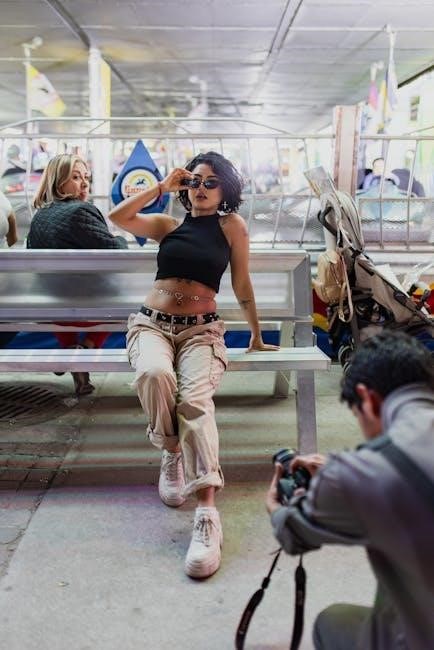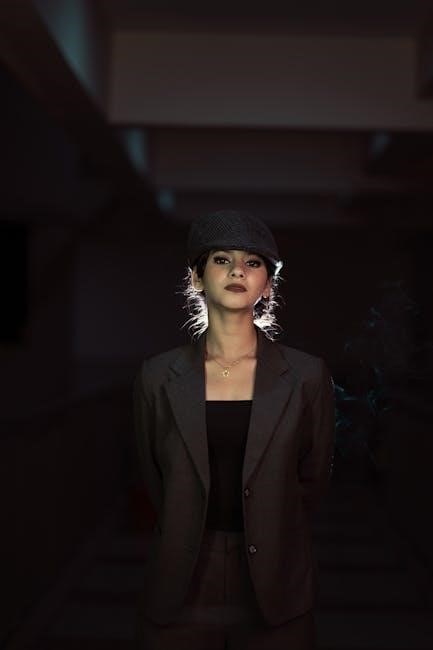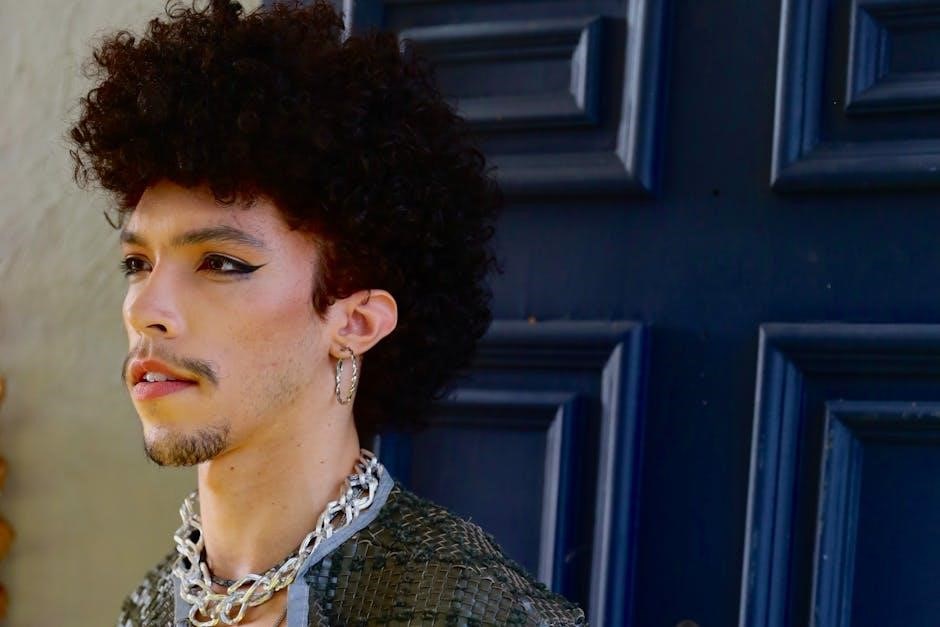A photography style guide is a powerful tool for refining creativity‚ mastering techniques‚ and showcasing work․ It helps photographers develop a consistent visual identity‚ ensuring their images convey a clear artistic vision while maintaining professionalism and coherence across all projects․
Understanding the Importance of Consistency in Photography
Consistency is crucial in photography as it builds a recognizable personal brand and enhances professional credibility․ A uniform style ensures your work is instantly identifiable‚ creating a cohesive portfolio․ By maintaining consistent composition‚ lighting‚ and editing techniques‚ you establish a strong visual identity․ This reliability helps audiences connect emotionally with your art‚ turning individual photos into a compelling‚ unified story that reflects your unique vision and artistic integrity․
Key Elements of a Photography Style Guide
A photography style guide outlines the essential components for maintaining visual consistency․ It includes guidelines on composition‚ lighting‚ and editing styles to ensure a cohesive look․ Additionally‚ it covers color palettes‚ camera angles‚ and storytelling techniques to reflect a photographer’s unique vision․ By documenting these elements‚ the guide helps create a recognizable visual identity‚ making it easier to produce work that aligns with a personal or professional brand․ Consistency is vital for building a professional portfolio and attracting a dedicated audience․
Composition and Visual Elements
Composition and visual elements are fundamental to photography‚ guiding balance‚ focus‚ and visual flow․ They ensure images are engaging and aligned with the photographer’s artistic intent․
The Rule of Thirds: Enhancing Visual Balance
The rule of thirds is a fundamental principle in photography that enhances visual balance by dividing the frame into thirds both horizontally and vertically․ This technique helps create dynamic compositions by placing key elements along these lines or at their intersections․ It avoids a static feel‚ making images more engaging․ Widely used in graphic design and UI‚ it ensures subjects are off-center‚ leading to more interesting and balanced visuals while maintaining flexibility for creative experimentation․
Symmetry and Patterns in Photography
Symmetry and patterns add depth and structure to images‚ creating visually appealing compositions․ Symmetry‚ often found in architecture or nature‚ produces a sense of order and balance․ Patterns‚ whether natural or man-made‚ introduce texture and rhythm․ Both techniques enhance storytelling by drawing the viewer’s eye to key elements․ Using these elements thoughtfully ensures consistency and elevates the professionalism of your work‚ making your photography style distinct and engaging while maintaining artistic coherence across your portfolio․
Lighting Techniques
Lighting is a cornerstone of photography‚ setting the mood and creating depth․ It enhances visual narratives and atmosphere effectively‚ making it a powerful tool for photographers․
Natural Lighting: Mastering Time and Direction
Natural lighting is a photographer’s most powerful tool‚ offering unparalleled authenticity․ The golden hour‚ just before sunrise‚ provides soft‚ warm tones‚ while midday light can create sharp‚ detailed images․ Understanding direction is key—side light adds depth‚ backlight creates silhouettes‚ and front light simplifies compositions․ Overcast days soften shadows‚ reducing harsh contrasts․ By planning shoots around these factors‚ photographers can harness natural light to evoke emotions and enhance narratives in their work effectively․
Artificial Lighting: Creating Mood and Atmosphere
Artificial lighting is a versatile tool for shaping the mood and atmosphere of images․ Techniques like side lighting can add depth and dimension‚ while backlighting creates dramatic silhouettes․ Using softboxes or diffusers softens shadows‚ producing flattering portraits․ Experimenting with color temperatures‚ such as warm tones for coziness or cool tones for a modern feel‚ enhances emotional impact․ Mastering artificial lighting allows photographers to craft unique ambiance‚ even in controlled environments‚ ensuring consistency in their style and vision․

Camera Angles and Perspectives
Camera angles and perspectives transform ordinary shots into compelling visuals․ Eye-level shots create authenticity‚ while bird’s eye views offer unique vantage points․ Dynamic angles add energy and storytelling depth‚ enabling photographers to convey their vision effectively through intentional composition and creative viewpoint selection․
Eye-Level and Bird’s Eye View Photography
Eye-level photography creates authenticity by aligning the camera with the subject’s perspective‚ fostering relatability․ Bird’s eye view offers a unique vantage point‚ capturing scenes from above to reveal patterns‚ textures‚ and context․ Both techniques enhance storytelling‚ with eye-level shots drawing viewers into the subject’s world and bird’s eye views providing a broader‚ often artistic perspective․ These angles‚ when combined with thoughtful composition and lighting‚ elevate images and align with a photographer’s style guide for consistency and visual impact․
Dynamic Angles for Storytelling
Dynamic angles add depth and emotion to photographs‚ transforming ordinary scenes into compelling narratives․ Shooting from low angles can convey power‚ while high angles may evoke vulnerability․ Dutch angles create tension‚ tilting the horizon to add drama․ Experimenting with these perspectives allows photographers to capture unique viewpoints‚ drawing viewers into the story․ Consistent use of dynamic angles aligns with a style guide‚ ensuring visual coherence and reinforcing the photographer’s artistic intent across their body of work․

Color Palettes and Post-Processing

Color palettes and post-processing techniques are essential for creating a cohesive visual identity․ Consistent editing enhances mood and style‚ ensuring images align with a photographer’s artistic vision and brand․
Choosing a Cohesive Color Scheme
Selecting a cohesive color scheme is vital for maintaining visual consistency․ Colors should reflect the mood and style of the photography‚ ensuring harmony across all images․ Natural palettes often emphasize earthy tones‚ while bold schemes can create striking contrasts․ Consistency in color choice helps tie a portfolio together‚ making it instantly recognizable․ Tools like color wheels and online resources can aid in curating a palette that aligns with the photographer’s vision‚ ensuring a polished and professional aesthetic in every frame․
Editing Styles: Preserving Consistency
Consistent editing styles are crucial for maintaining a cohesive look in photography․ This involves using uniform adjustments for brightness‚ contrast‚ and saturation to ensure a recognizable aesthetic․ Presets and standardized workflows can help achieve this consistency‚ as they apply the same enhancements across all images․ Regularly reviewing and refining your editing approach ensures your portfolio remains polished and aligned with your artistic vision‚ making it easier for audiences to connect with your work on a deeper level․
Storytelling Through Photography
Photography is a powerful medium for storytelling‚ capturing emotions‚ and conveying narratives․ It allows photographers to communicate ideas‚ evoke feelings‚ and share experiences through visual context and creativity․
Capturing Emotions and Narratives

Capturing emotions and narratives in photography involves conveying a story or feeling through images․ Techniques like composition‚ lighting‚ and subject interaction help create authenticity‚ making photos relatable and impactful․ A strong narrative engages viewers‚ encouraging them to connect emotionally with the scene․ Authenticity is key‚ ensuring the image reflects real moments or genuine expressions․ This approach transforms photography into a powerful storytelling medium‚ allowing photographers to communicate deeper meanings and evoke lasting impressions․

Using Props and Styling for Context
Props and styling add depth and context to photographs‚ enhancing storytelling by creating a cohesive visual narrative․ Thoughtfully chosen objects guide the viewer’s eye‚ emphasizing themes or emotions․ Props should be relevant yet subtle‚ avoiding distraction while enriching the scene․ Consistency in styling ensures a unified look‚ making images recognizable and impactful․ From vintage items to seasonal elements‚ props help photographers craft meaningful stories‚ transforming ordinary moments into extraordinary visual experiences that resonate deeply with audiences․
Building a Personal Photography Style
Developing a unique style involves experimenting with techniques‚ studying inspirations‚ and refining approaches to create a distinctive visual language that reflects your artistic voice and vision․
Experimentation and Inspiration
Experimentation is key to discovering your photographic voice․ Try various techniques‚ study the work of others‚ and draw inspiration from art‚ nature‚ or personal experiences․ Analyze what resonates with you and adapt it to your unique perspective․ Inspiration can come from unexpected places‚ so stay curious and open to new ideas․ Over time‚ these explorations will help you refine your style and create a cohesive‚ recognizable body of work that reflects your artistic vision․
Documenting Your Evolution as a Photographer
Tracking your growth as a photographer is essential for refinement and improvement․ Maintain a portfolio or journal to record your progress‚ reflecting on past projects and techniques․ Regularly reviewing your work helps identify strengths‚ weaknesses‚ and areas for development․ Over time‚ this documentation reveals your artistic journey‚ showcasing how your style and skills have evolved․ It also provides valuable insights for future projects‚ ensuring continuous growth and a clear vision for your photography․
Consistency is key to a strong photography style․ Regularly review and update your style guide to reflect growth and maintain a cohesive visual identity‚ ensuring your artistic vision remains clear and impactful․
Reviewing and Updating Your Style Guide
Evaluating your photography style guide regularly ensures visual coherence and artistic growth․ Update your guide to reflect new techniques‚ trends‚ or personal creative shifts‚ maintaining a consistent yet evolving aesthetic․
Refine your approach by incorporating feedback and experimenting with fresh ideas․ This process keeps your work dynamic and aligned with your artistic vision‚ while also inspiring continuous improvement and innovation in your photography practice․
Sharing Your Vision with the World
Sharing your photography style guide allows others to appreciate your artistic vision and creative process․ Showcase your work on platforms like social media‚ websites‚ or portfolios to connect with audiences globally․ Use high-quality images and descriptive captions to highlight your unique approach․ Engage with your audience by explaining your inspirations and techniques‚ fostering a deeper understanding of your art․ This exchange not only builds your brand but also inspires others to explore their own photographic journeys․
